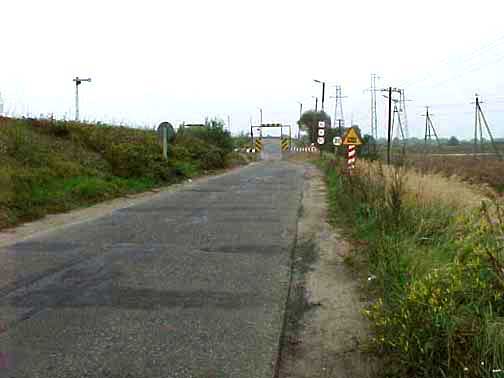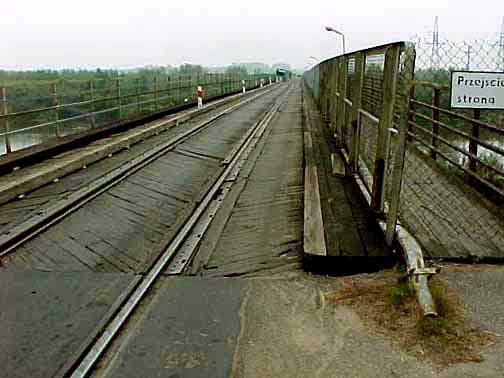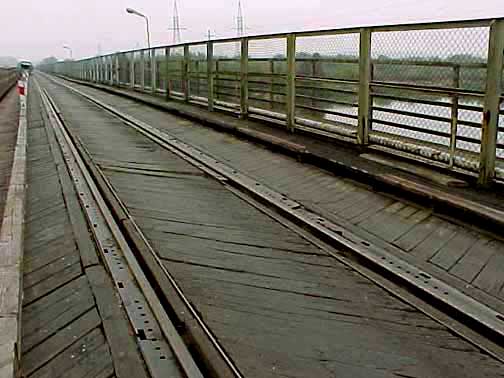Approaching Treblinka

Arch over road prevents
buses and trucks from entering
As you get near the village of Treblinka,
there is a line of beautiful chestnut trees alongside the road
on the right. You see old men walking along the road, carrying
bundles of sticks on their backs. There are farm families digging
potatoes and burning the dried potato vines in the fields. Occasionally,
you see a stork's nest on a roof near the chimney, or a large
ant hill at the edge of a forest, surrounded by a tiny log fence
for protection. There are old wooden Catholic churches and
white cottages with thatched roofs along the road. Telephone
poles are topped with glass insulators, the kind you see for
sale in antique stores in America. The farther you travel down
this road, the farther you seem to go back in time.
Near Malkinia Junction, the road now
has ancient concrete barriers to prevent cars from leaving the
road, and quaint old railroad crossing signs. From this junction,
a branch line runs south from the Ostbahn (Eastern Railroad line)
to the village of Treblinka where there was a small train station
in the 1940ies.
Finally you get to a narrow archway over
the road, the purpose of which is to keep vehicles larger than
2.5 tons from proceeding beyond this point. The arch is shown
in the photograph above. Just before you get to the camp, you
must cross a one-lane railroad bridge that was formerly used
by both trains and cars, but is now used only by cars and pedestrians.
According to Martin Gilbert in his book "Holocaust Journey,"
this bridge was rebuilt some time after 1959; the bridge had
been destroyed during World War II. The reconstructed bridge
is shown in the photograph below.

Bridge over Bug river
for trains, cars and pedestrians
The surface of the bridge is made of
wood and the train tracks are not level, which would cause any
train using the bridge to list to one side. The tracks of the
railroad lines in Germany and Poland were then, and still are
today, a different width, or gauge, than the tracks across the
eastern border of the Bialystok District in what used to be the
Soviet Union, and is now the country of Byelorussia or Belarus,
formerly called White Russia.
According to my tour guide, today trains
from Germany or Poland must stop at the Bialystok eastern border
and change to wider wheels which can run on the different gauge
tracks in Russia. In 1941, it was necessary for the German invading
army to extend the standard European gauge tracks into Russia,
as they advanced. The poor condition of the roads in Poland and
Russia hampered the advancing Germany troops when their vehicles
would become mired in three feet of mud. Three kilometers from
Treblinka was located the main railroad line into Russia, through
the Bialystok province.

Tilted train tracks
on bridge over Bug river
After the joint conquest of Poland by
the Germans and the Russians in September 1939, the river Bug
(pronounced Boog) became the border between the German-occupied
General Government of Poland and the Russian zone of occupation;
then Germany invaded the Soviet Union in June 1941 and conquered
the strip of eastern Poland that was being occupied by the Russians.
Treblinka is located in the former General Government.
On January 20, 1942, a conference was
held in Wannsee, a suburb of Berlin, where plans were made for
the "Final Solution to the Jewish Question." Three
extermination camps, called the Operation Reinhard Camps were
planned at this conference. Treblinka was the last of the Operation
Reinhard camps to be set up; the other two were Sobibor and Belzec.
All three of the Operation Reinhard camps were located on the
western side of the Bug river. There is a bend in the river near
Treblinka, which required a bridge over the river in order to
get to the village of Treblinka, although the village is located
on the western side of the border between the former General
Government and the Russian zone of occupation.
Hardly more than a creek, the Bug is
shallow enough in some places so that one can wade across it,
and according to historian Martin Gilbert, some refugees, from
both sides, did wade across. The movie "Europa, Europa"
has a scene in which Jewish refugees are shown walking toward
the Russian sector, trying to escape the Nazis in September 1939
by crossing the Bug river on rafts.
This page was last updated in 2002
|